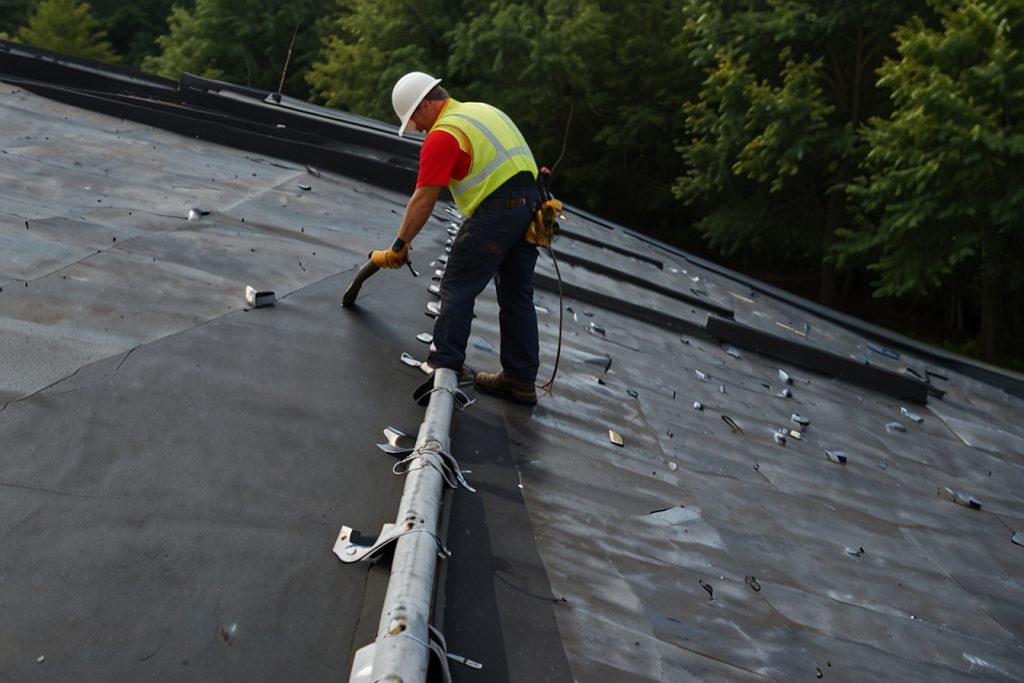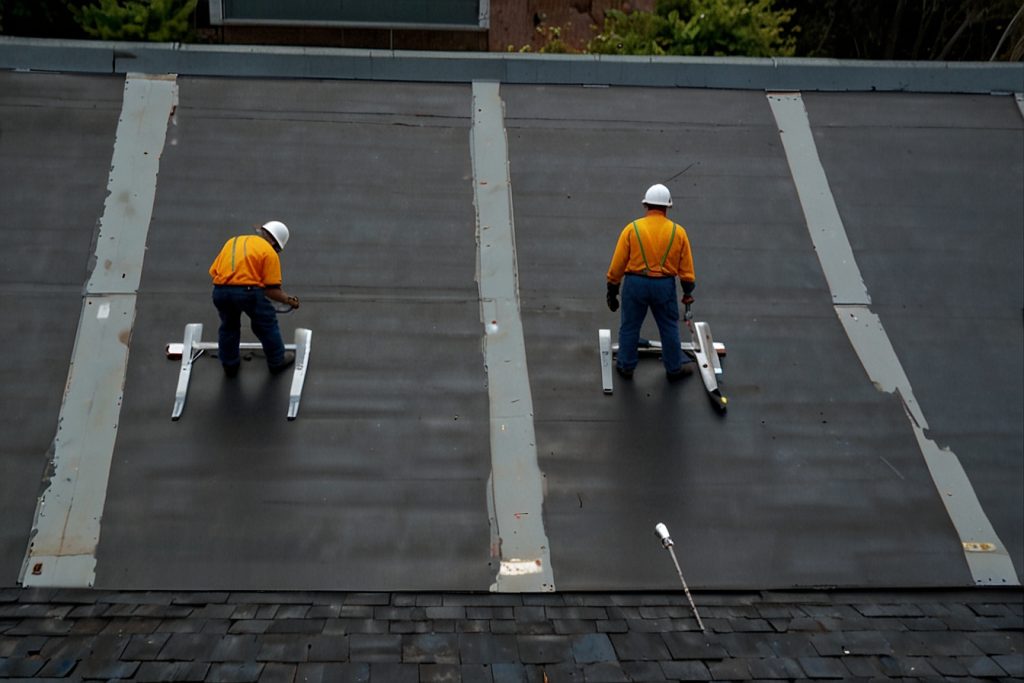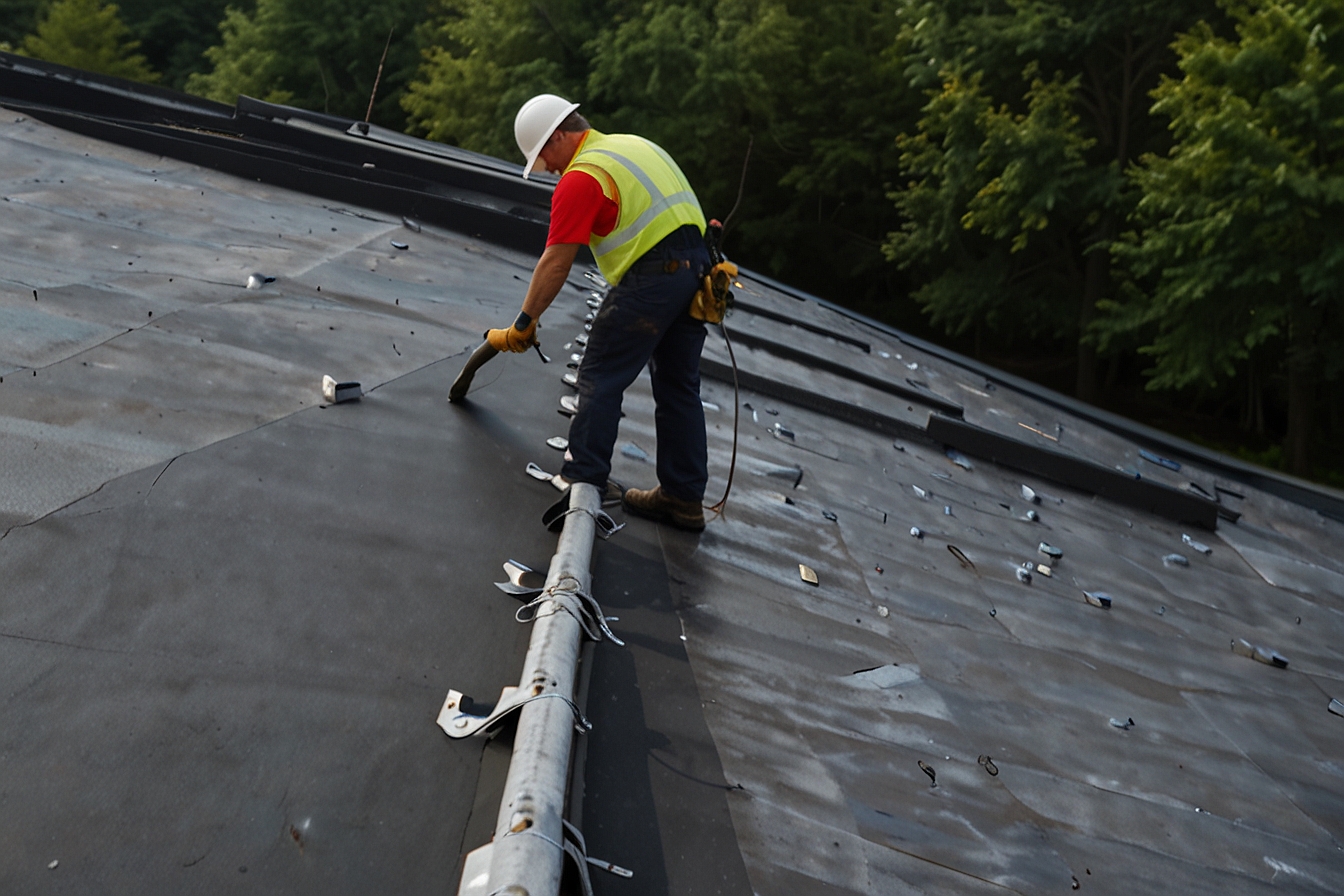What is Commercial Roofing: Understanding Materials and Maintenance Requirements
Commercial roofing encompasses the materials and methods used to seal and protect the roofs of commercial buildings. These differ from residential roofing in scale, shape, and materials. The primary objective is to maintain the building’s integrity and protect the valuable assets and activities inside from the weather.
Roofing systems for commercial structures are typically large-scale projects. They require a keen understanding of industry-grade materials and installation practices.
Various roofing systems are available for commercial buildings, each with its specific benefits and challenges. Examples include single-ply membranes such as TPO, PVC, EPDM, which are known for their durability and ease of installation. More traditional options like built-up roofing (BUR) or modified bitumen are also available. Metal roofing is another option, prized for its longevity and recyclability, which aligns with industry efforts to reduce environmental impact.
Charles Jimerson the founder of CJ Commercial Roofing NJ had this to say “When considering commercial roofing, factors such as the building’s design and weather patterns in the region are crucial. The roof’s slope or flatness are also important elements that will inform the choice of the appropriate roofing system and materials.”

Types and Materials of Commercial Roofing
Commercial roofing differs significantly from residential roofing due to its materials and installation methods. Understanding the specific types and materials is essential for making informed decisions about commercial roofing projects.
Single-Ply Roofing Systems
Single-Ply Roofing Systems are widely recognized for their simplicity in installation and overall cost-effectiveness. These systems include:
- Thermoplastic Polyolefin (TPO): TPO is favored for its reflective properties and strong resistance to UV light and chemical exposure. These single-ply membranes are typically installed using mechanical fasteners, fully adhered, or ballasted systems.
- Polyvinyl Chloride (PVC): PVC roofs are durable and resistant to impact, chemicals, and fire. Installation often involves heat-welding the seams to create a watertight bond.
- Ethylene Propylene Diene Monomer (EPDM): Recognized as a durable thermoset material, EPDM, or rubber roofing, is lauded for its longevity and ease of repair. It’s often secured with adhesive, ballasted with stone, or mechanically attached.
Metal Roofing Solutions
Metal Roofing Solutions stand out for their durability and aesthetic appeal. Here’s a glance at the metal options:
- Steel: Often coated with zinc or a mixture of zinc and aluminum to prevent rust.
- Aluminum: Lightweight and corrosion-resistant, making it a good choice for coastal areas.
- Copper: Long-lasting with a distinct appearance that develops a patina over time.
Metal roofs may come in the form of sheets or tiles, and common varieties include corrugated galvanized steel and stainless steel.
Built-Up and Modified Bitumen Roofing
Built-Up Roofing (BUR) systems include multiple layers of asphalt alternating with reinforcing fabrics, which provide a continuous sealed surface. BUR is known for its reliability and water-resistant capabilities.
Modified Bitumen Roofing (MB) consists of reinforced roof membranes combined with bitumen that have been modified with a rubber or plastic polymer to increase flexibility and strength.
Green Roofing Systems
Green Roofing Systems are an eco-friendly option that promotes energy efficiency and can help reduce the urban heat island effect. Here are the two common types:
- Extensive Green Roofs: These require minimal maintenance and are covered with drought-resistant plants.
- Intensive Green Roofs: They can support a wider variety of plants but need more maintenance and structural support.
Both types contribute to insulation and managing stormwater runoff, creating an excellent blend of aesthetics and environmental benefits.
Maintenance, Repair, and Sustainability

In commercial roofing, attention to maintenance, timely repairs, and sustainable practices is key to enhancing longevity, ensuring durability, and maximizing efficiency. My discussion focuses on these essential factors to help you understand their impact on the life and performance of commercial roofs.
Maintaining Commercial Roofs
Proper maintenance is paramount in extending the service life of a commercial flat roof. I recommend a biannual inspection as a standard practice to identify any issues like pooling water or damage from debris.
Regular upkeep, such as cleaning drains and gutters, helps to prevent water accumulation on the roof which can lead to leaks and structural damage. Establishing access protocols ensures contractors can perform maintenance tasks safely and effectively without causing additional harm to the roof.
- Inspection: Biannually
- Maintenance Tasks: Clean drains, remove debris
- Access: Safe, without causing damage
Common Roofing Repairs and Leak Prevention
Repairing a commercial roof at the first sign of wear or damage is critical in preventing small issues from becoming significant problems.
Punctures, membrane tears, and flashing damage are common in flat roofs, particularly on warehouses and buildings with heavy equipment.
To prevent leaks, a combination of reliable materials and expert workmanship is required. Roof coatings, especially liquid-applied acrylic coatings, provide an additional layer of protection, sealing minor punctures and making the roof more resistant to the elements.
- Typical Damages: Punctures, membrane tears, flashing issues
- Prevention: Regular inspections, reliable repair materials
- Coating: Acrylic or elastomeric coatings for added protection
Sustainable Roofing and Energy Efficiency
Sustainability in commercial roofing often means using materials and methods that promote energy efficiency. For example, green or cool roofs are popular choices. These roofing types can reflect ultraviolet light and provide better insulation. As a result, they can reduce energy costs significantly.
Eco-friendly options might include recycled roofing materials or systems that support vegetative layers. By choosing sustainable options, businesses can benefit from energy efficiency. They can also find that eco-friendly choices come with incentives or warranties. These can offset the initial investment.
- Green Roofs: Support vegetation, improve insulation
- Energy Efficiency: Reflective coatings, better insulation
- Benefits: Lower energy costs, possible incentives and warranties
